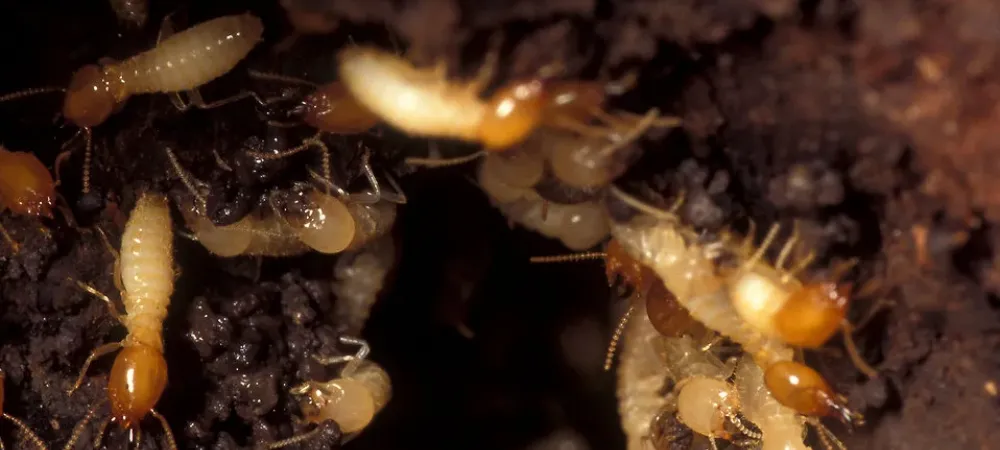The first step in preventing termites is to be on the lookout for them before too much damage is done. However, if you find that you have a termite infestation, you need to start a treatment plan as soon as possible. There are several termite treatment options for homeowners to consider which include:
An experienced pest control professional can review your termite concerns and help you determine which termite treatment is best for your home. Read more about which termite treatments could be beneficial for your property.
The Danger of Termites to Your Home
When it comes to termite damage, these pests can cause significant damage to your house. Termites can create costly structural damage to the flooring and framework of your home, making it unsafe to occupy until repairs and termite control treatments are done. As termites feed mostly on the inside of the wood, they can chew through your home’s framework with their powerful jaws to electrical wires leaving your home and family exposed to the risk of fire hazards. Home insurance carriers usually do not cover costly termite-related repairs, so prevention and early treatment are vital. Termite droppings are also hazardous and can cause respiratory illnesses and promote mold growth. To summarize, a termite colony can create costly structural damage and personal inconvenience in a very short time.
Soil & Barrier Termite Treatments
With soil and barrier termite treatments, a trench is dug around your home and the soil is treated with termiticide to act as a barrier. The trench is filled in with soil and any termites from your house that return back to the nest will be killed. This treatment also prevents future infestations.
Pros of Soil & Barrier Treatment
The soil and barrier treatment protects the interior and exterior of your home and is less invasive. This is one of the more common methods to treat termite infestations due to the relatively lower cost. The benefits of the soil and barrier treatment include:
- Termiticides usually last up to at least 5 years providing some longer coverage.
- It is usually a less expensive treatment option.
- Fast results are achieved after the treatment has been applied.
Cons of Soil & Barrier Treatment
As with any treatment, there are considerations that can compromise the effectiveness of the termite control plan. The soil and barrier treatment has some limitations including:
- It will only work on subterranean termites.
- If the soil under the barrier gets wet, gaps may be created allowing entry for the termites into your home.
- It’s more intrusive than baiting.
- Toxic soil spray applications are directly applied to the soil.
- Soil barriers lose effectiveness over time.
Bait Station Termite Treatments
Bait termite treatments are effective in destroying termite colonies long term. With this treatment method, several bait stations are placed around your home and are checked regularly and the bait is replenished as necessary. The termites are attracted to the bait stations, and they will bring the bait back to the colony which poisons them. These stations are effective in ensuring protection from current and future infestations by destroying the termite colony.
Pros of Bait Stations
There are above-ground and below-ground bait stations depending on the type of termite infestation you are encountering. This pest control strategy is more environmentally friendly compared to chemical treatments and has the following benefits:
- Bait stations are an effective long-term termite control solution.
- It can destroy an entire colony at the source.
- Drilling or digging around your home is not necessary.
- Fewer health risks with decreased exposure to termiticide.
Cons of Bait Stations
Bait stations have many benefits, however, there are some limitations to be considered with this form of treatment. Although it is a tried and true form of termite control, the things you should consider are:
- It can be more costly than soil barrier treatments.
- Bait stations require training and consistent monitoring.
- The results may take time and are not immediate.
Wood Termite Treatments
Before a termite invasion, you may want to consider using termite-resistant or pressure-treated wood in and around your home. After an invasion, wood termite treatments require targeting the wood structural components of your home and any outdoor furniture or sheds composed of wood. There are borate surface sprays, injected sprays, and foams or wood sealants to prevent and deter termite invasions.
Pros of Wood Treatments
Wood treatments are a proactive approach to termite control. This approach is effective during the construction of your home or can be incorporated to treat a termite problem in your existing home. There are several benefits:
- It is less expensive and cost-effective.
- Several termite-resistant wood options exist including pressure-treated wood, cedar, teak, and redwood.
- Wood sealant can be applied to existing wood to prevent moisture and rotting which are environments that attract termites.
Cons of Wood Treatments
Wood treatments are not very effective if you are experiencing an invasion of termites. These treatments just make your home less inviting. That being said, wood treatments are a good preventative measure and can greatly reduce the number of termites attracted to your home. However, with wood treatments:
- An active termite invasion will not be eradicated.
- Sprays and sealants may need to be reapplied if exposed to weather conditions and moisture.
- It is difficult to find and treat every wooden surface that may attract termites.
- This treatment option can be invasive.
Fumigation Termite Treatments
Fumigation is helpful in removing severe termite infestations. The affected area is sealed off and a special gas of sulfuryl fluoride known as Vikane is released into the affected area. The process can take at least 3 days to complete. Fumigation allows for the entire termite colony to be destroyed.
Pros of Fumigation Treatments
Fumigation is recommended for termite infestations that are drastic and pervasive. This treatment will completely eradicate the termite colony over a period of days and provide the following benefits:
- Your peace of mind knowing that the termite colony is destroyed in the affected area.
- Vikane gas will not leave a residue and will naturally disperse.
- Your home will be aerated and monitored for safe re-entry.
Cons of Fumigation Treatments
Fumigation termite treatments are invasive to your home. While this termite control option is effective for severe infestations, there are several points to consider before selecting this form of treatment:
- Fumigation is the most costly and invasive treatment.
- It is disruptive as you, your family, and any pets must leave your home for at least three days.
- It targets the current infestation, but will not prevent a future termite colony from forming.
- The effectiveness depends on the type of termite species. Fumigation is not effective against the common subterranean termite and their underground nests.
What are DIY Solutions to Prevent Termites?
You can make your home much less appealing to termites by following a few simple routines. These DIY solutions are effective measures to prevent these pests from finding a food source in and around your home.
- Store firewood and scrap wood away from your residence.
- Clean your gutters regularly so that moisture and wood particles are removed.
- Keep basements and crawl spaces dry and well-ventilated.
- Seal any cracks or crevices in your foundation or walls.
- Treat wood with boric acid and orange oil to repel termites.
Professional Termite Treatment
Connor’s Pest Pros are experts in treating termite infestations in the Metro DC and NoVa areas. Our highly trained exterminators will determine if termites are active in your home with a thorough inspection. After this, we’ll quickly get rid of them using our strategically placed bait stations! Our termite treatment is quick and takes care of termites at their source. We offer same-day services and our 100% satisfaction guarantee, so contact Connor’s Pest Pros today!



